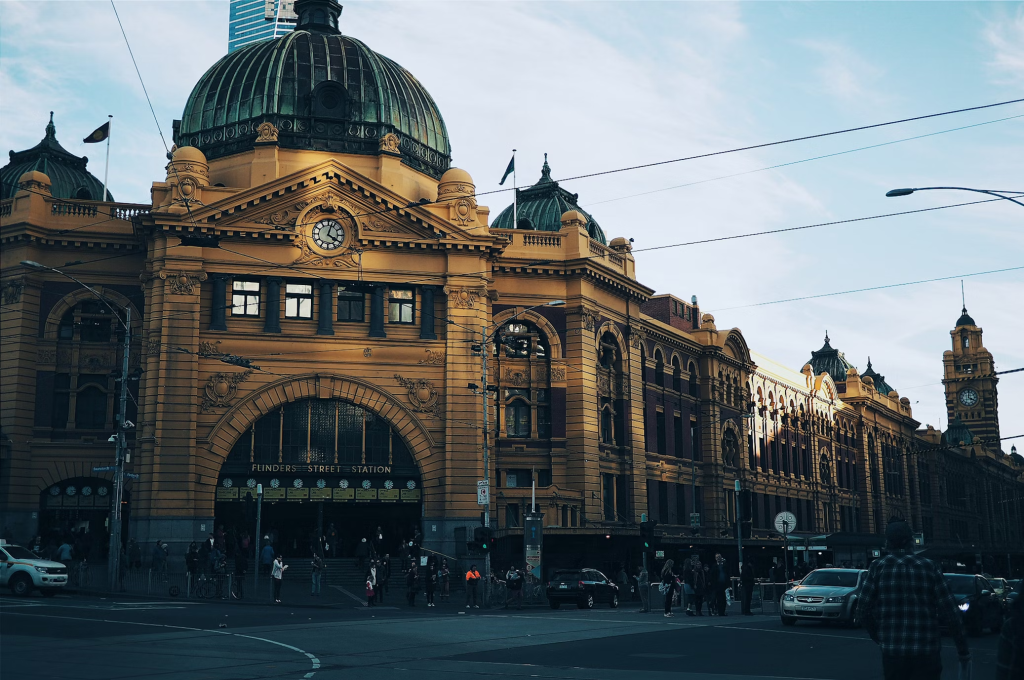Nestled in the heart of Melbourne, Flinders Street is more than just a thoroughfare; it’s a gateway to the city’s rich history, culture, and bustling life.

This iconic street, stretching from the vibrant Flinders Street Station to the Yarra River, is a magnet for both locals and tourists.
The charm of Flinders Street lies in its eclectic mix of historic architecture, cultural landmarks, and a vibrant atmosphere that captures the essence of Melbourne.
As one of the city’s most prominent streets, Flinders Street is not only a hub for transportation but also a centre for cultural and social activities.
In this article, we’ll explore what Flinders Street is best known for, delve into its historical significance, uncover its cultural highlights, and discuss why it remains a favourite among both locals and visitors.
What Is Flinders Street Best Known For?
Flinders Street is perhaps best known for its iconic train station, Flinders Street Station, which has been a central meeting point and a symbol of Melbourne since its opening in 1910.
The station’s distinctive yellow façade and green copper dome are recognized worldwide, making it one of the most photographed landmarks in the city.
Located on the corner of Flinders and Swanston Streets, the station serves as a major transportation hub, connecting thousands of commuters to various parts of the city and beyond.
The phrase “I’ll meet you under the clocks” has become a staple in Melbourne’s vocabulary, referring to the row of clocks above the main entrance of the station that display the departure times of various train lines.
Flinders Street is also known for its vibrant street culture. The area around the station is often filled with buskers, artists, and performers showcasing their talents to passersby.
The street itself is lined with a variety of cafes, restaurants, and shops that cater to a diverse crowd, from early-morning commuters grabbing a quick coffee to tourists exploring the city’s offerings.
Additionally, the proximity of Flinders Street to the Yarra River and Southbank makes it a popular starting point for leisurely walks along the river or visits to nearby attractions such as Federation Square and the Arts Centre Melbourne.
Moreover, Flinders Street serves as a gateway to some of Melbourne’s most significant cultural institutions.
Federation Square, located directly across from Flinders Street Station, is home to the Ian Potter Centre: NGV Australia, and the Australian Centre for the Moving Image (ACMI), making Flinders Street a cultural hotspot for art enthusiasts and film buffs alike.
This convergence of transportation, culture, and commerce makes Flinders Street a vital artery in the lifeblood of Melbourne, reflecting the city’s dynamic and inclusive spirit.
Historical Significance Of Flinders Street
Flinders Street holds a deep historical significance in Melbourne’s development. Named after the British explorer Captain Matthew Flinders, who mapped the coastline of Australia, the street has been central to Melbourne’s growth since the city’s early days.
Flinders Street Station itself was built on the site of Melbourne’s first railway station, which opened in 1854 and marked the beginning of Melbourne’s transformation into a major urban centre.
The station building, with its Edwardian Baroque architecture, was the first railway station in an Australian city and became a model for others that followed.
In the late 19th and early 20th centuries, Flinders Street evolved into a bustling commercial hub.
The construction of the station coincided with Melbourne’s “Marvellous Melbourne” era, a period of rapid expansion and prosperity fueled by the gold rush.
During this time, the street became lined with important commercial buildings, including the Banana Alley Vaults, which were used for the storage and sale of fresh produce, highlighting the street’s role in Melbourne’s economic activity.
Flinders Street has also been a witness to numerous historic events. It has been the stage for parades, protests, and public celebrations that have shaped the social and political landscape of Melbourne.
For instance, during World War II, Flinders Street was a focal point for public gatherings and farewells for soldiers heading to war. In more recent times, it has been the site for various social movements and community gatherings, reinforcing its place as a central artery in Melbourne’s civic life.
The street’s architecture tells the story of its evolution.
From the Victorian-era buildings that line its path to the modern skyscrapers that now dominate its skyline, Flinders Street showcases Melbourne’s transition from a colonial outpost to a modern metropolis.
The preservation of many historic buildings along the street, such as the Young & Jackson Hotel and St. Paul’s Cathedral, alongside newer developments, creates a fascinating contrast that captures the essence of Melbourne’s historical and contemporary narrative.
Cultural Highlights Along Flinders Street
Flinders Street is not just a historical landmark; it’s also a cultural epicentre that offers a variety of experiences for art lovers, food enthusiasts, and history buffs.
One of the most prominent cultural highlights along Flinders Street is Federation Square. Opened in 2002, Federation Square is a public space that has become a cultural precinct and gathering place for Melburnians and visitors alike.
It houses several cultural institutions, including the Ian Potter Centre: NGV Australia, which showcases Australian art from colonial times to contemporary works, and ACMI, which focuses on film, television, and digital culture.
Another cultural gem on Flinders Street is St. Paul’s Cathedral. This Anglican cathedral, with its stunning Gothic architecture and beautiful stained-glass windows, provides a serene counterpoint to the bustling city outside.
It’s a place where visitors can pause for a moment of reflection amidst the hustle and bustle of city life. The cathedral often hosts concerts and events, adding a musical element to its spiritual offerings.
For those interested in Melbourne’s vibrant street art scene, Flinders Street is just a short walk away from Hosier Lane, one of the city’s most famous street art locations.
This laneway is a dynamic canvas that changes frequently as artists add new works, making it a must-visit spot for anyone interested in contemporary urban art.
Food and drink are also central to the cultural experience of Flinders Street.
From the historic Young & Jackson Hotel, famous for its painting “Chloé” and its extensive range of beers and ciders, to the numerous cafes and restaurants that offer everything from gourmet burgers to high-end dining, there’s something to satisfy every palate.
The street’s culinary offerings reflect Melbourne’s diverse culture, making it a great place to explore the city’s food scene.
The Enduring Appeal Of Flinders Street
The enduring appeal of Flinders Street lies in its ability to blend the old with the new, the traditional with the modern.
Its central location and proximity to some of Melbourne’s most significant landmarks and attractions make it an essential part of any visit to the city.
The street’s rich history, iconic architecture, and vibrant culture make it a microcosm of Melbourne itself—a city that prides itself on its diversity, creativity, and heritage.
Whether you’re a history enthusiast exploring the architectural wonders, a foodie sampling the diverse culinary delights, or a culture vulture immersing yourself in the city’s artistic offerings, Flinders Street has something for everyone.
Its ability to continually adapt and evolve while preserving its historical roots ensures that it remains relevant and beloved by all who walk its length.
Conclusion
Flinders Street is more than just a street; it is a testament to Melbourne’s rich history, cultural diversity, and dynamic spirit.
From the iconic Flinders Street Station and the bustling activities around Federation Square to the historical landmarks and cultural experiences that line its path, Flinders Street embodies the essence of Melbourne.
It is a place where past and present converge, offering a unique blend of history, culture, and modern-day charm. Whether you are a local or a visitor, Flinders Street invites you to explore and experience the heart of Melbourne in all its vibrancy and diversity.
Looking for more information? Click and visit flinders street station facts, today!



